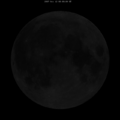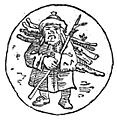Hjúki and Bil facts for kids
Hjúki and Bil are a brother and sister from Norse mythology. They are known for following Máni, who is the Moon as a person. This means Máni is like a god who represents the Moon.
Their story is found in a book called the Prose Edda. This book was written in the 13th century by a famous Icelandic writer named Snorri Sturluson. Some people believe that Hjúki and Bil might represent the different phases of the Moon.
Contents
The Story of Hjúki and Bil
The story tells us that Hjúki and Bil were carrying a pail of water. They had just gotten the water from a special, sacred well. Suddenly, Máni, the Moon god, swooped down from the sky. He quickly grabbed their pail of water.
After Máni took their pail, the two children started to chase him. They wanted to get their pail back. So, Hjúki and Bil are always following Máni across the sky. This is why they are often seen with the Moon.
Who Was Snorri Sturluson?
Snorri Sturluson was an important writer and historian. He lived in Iceland during the 13th century. He wrote down many old Norse myths and legends. His work helps us understand the beliefs of the Vikings and other Norse people. The Prose Edda is one of his most famous books. It is a key source for learning about Norse mythology.
Hjúki and Bil in Folklore
Some people think the story of Hjúki and Bil is very old. It might even be connected to other stories around the world. For example, the English nursery rhyme about Jack and Jill is sometimes linked to them. In that rhyme, Jack and Jill go up a hill to fetch a pail of water. They both fall down, just like Hjúki and Bil might be seen as "falling" or chasing the Moon. This shows how old stories can sometimes be similar across different cultures.
Images for kids
-
Jack and Jill, proposed as connected to Hjúki and Bil
See also
 In Spanish: Hjúki y Bil para niños
In Spanish: Hjúki y Bil para niños




